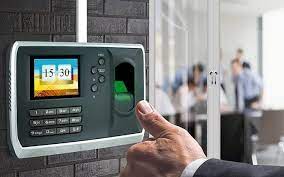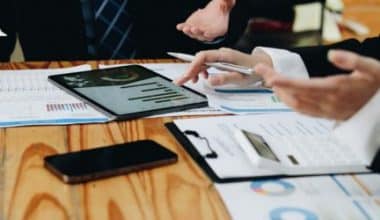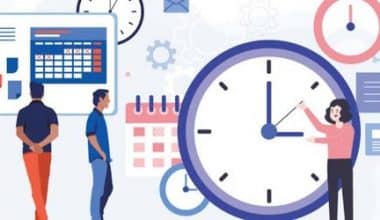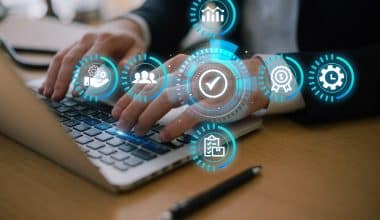Employees can input and track their own hours with time attendance systems, relieving the employer of this duty. Businesses, on the other hand, have saved money, enhanced production, and complied with labor rules by speeding the attendance process. In guide will lead to your upper understanding of how clocking in machine works, how to use the digital fingerprint with its covered law.
Clocking In Machine
A time clock, also known as a punch clock, clock card machine, or time recorder, is a device that records the start and end times of a company’s hourly (or flexi-time) employees. Companies in China manufacture electronic time clock machines in a variety of configurations that are sold in countries throughout the world under a variety of brand names, as well as software that collects data from a single or numerous time clock machines and transforms it into reports. Time clocks are classified into five types:
#1. Punch Card Clocks
Employees enter a paper card into a machine as they enter and exit the building. To designate the start and end timings, the machine however stamps, the card with the date and time. Because of their simplicity, these clocks are most commonly useful by small organizations that do not use remote workers.
#2. Digital Clock
Employees swipe a magnetic stripe-enabled card through a machine connected with a digital time clock rather than punching a card. The machine records the punch-in date and time for the payroll department to use later. Another sort of digital clock that does not require personnel to carry a card is an electronic touchpad. Rather, workers enter data into a machine using a personal code that saves it automatically.
#3. Time Station Software
Employees use time station software installed on a personal computer to clock in and out. For all punch-ins, employees use a single computer. Organizations, on the other hand, can use the application in conjunction with a personal computer to allow employees to clock in and out at their own workstations. Time station software has the advantage of being able to link time data with payroll software, which streamlines payroll processing.
#4. Fingerprint Clocks
Individuals are in recognition using biometric time clocks relating to their unique human characteristics, such as a fingerprint. Employees place their fingers on a scanner, which compares it to an image stored in a database to determine their identity. If the match is correct, the time clock machine makes an audible thank you sound.
Because a fingerprint cannot be reproduced, biometric fingerprint time clocks prevent buddy punching and fraud. Employees will also no longer have to worry about forgetting a code or forgetting to bring their punch cards to work. It’s difficult to overlook a body portion!
#5. Hand-Punch Clocks
Another type of biometric authentication equipment is a hand punch clock. Instead of a fingerprint, these clocks use the palm of the worker’s hand to validate his or her identity. To validate the worker, a scanner compares a portion of the worker’s palm to a previously saved database image. Fingerprint clocks, for example, contribute to the avoidance of buddy punching and fraud.
Fingerprint Clocking In Machine
A fingerprint clocking machine gives your company precise, accurate time and attendance data. Employees cannot clock in or out together due to biometric security, which prohibits buddy clocking. Attendance data is however in link with our in-house timesheet software in the UK, making payroll processing easier. A fingerprint time and attendance system is thus appropriate for organizations of all sizes and scales fast to support businesses with several locations.
How the Fingerprint Attendance Clocking System Works
Here is how fingerprint clocking in the machine works.
#1. Clocking Methods
Fingerprint clocking is straightforward and quick and eliminates the possibility of employees clocking in and out simultaneously. In addition to secure biometric clocking, the C200 system supports proximity clocking by badge or keyfob. Each day, employees can register up to 16 fingerprint or proximity attendance events, which will be confirmed verbally and visually. The C200’s biometric security can be very strong with the use of a personal PIN.
#2. Registration and Documentation
The procedure for registering your fingerprints is quite simple. Thus each employee may have many biometric records filed to guard against accidents or damage to a specific fingerprint. The C200 time clock machine has a capacity of up to 1000 personnel.
#3. Download and Storage of Data
The C200 fingerprint machine stores clocking data until it is uploaded via LAN or USB to our time and attendance software. Individual timesheets can be generated here, as well as comprehensive reports for managing attendance and payroll data. Your personal information is securely stored on your computer or server.
Fingerprint Clocking In Machine Law
The Data Protection Act of 1998 is the most important piece of legislation that applies to biometrics. According to the Act, anybody who processes personal data must meet eight conditions. Among the law that rule the fingerprint clocking machine are as follows:
- Data processing that is ethical and legal
- Purpose-specific processing
- Data storage that is adequate, relevant, and not excessive
- Maintaining up-to-date and correct data
- Ensuring that data is only kept for as long as necessary
- Ensuring that data is handled in accordance with relevant laws and regulations
- Maintain data security
- Preventing data transmission to nations where it will not be adequately safeguarded.
The first, second, fifth, and seventh (highlighted) principles are the most applicable law to this clocking in fingerprint machine situation. They provide the following protections:
- To ensure fair and legitimate data processing, employers must ensure that employees are informed and understand why their personal data is being processed.
- Keeping biometric data for specified purposes necessitates that it not be utilized for any other purpose than the one for which it was obtained.
- The fifth principle underlines the need not to retain personal data indefinitely. This means that employees’ biometric data should be erased as soon as they leave the firm.
- Biometric data should be safeguarded from illegal processing, loss, destruction, or damage, according to the security principle.
Digital Clocking In Machine
A self-calculating clock-in system is an efficient human resource management tool for monitoring and controlling your employees’ working hours. Your human resources manager will thus know exactly how much pay and benefits each employee is entitled to by just checking in and out of the machine. Furthermore, various electronic systems can provide data on total hours worked, which can help you plan for the upcoming week’s spending.
How Secure are Digital Clocking-in Machine?
When acquiring a digital clocking-in machine, employers and managers may be concerned about employee fraud. While mechanical technologies provide limited security features, electronic alternatives may provide the following advantages:
- Biometric Recognition: You can be guaranteed that the individual checking in is a legitimate employee by using fingerprint or retina scanning.
- Login Registration: To prevent employees from unintentionally clocking in with someone else’s card, require them to log in with their own login and password.
- Virtual Clocking-in: Track when employees clocks in and out of their computer and use the timestamp to establish office hours.
- Internet Connection: Physical clock-in equipment is frequently linked to your company’s Wi-Fi or intranet, allowing for real-time updates.
Can The Digital Clocking-in Machine be Integrated with a Staff Card?
Yes. If your firm issues employee ID cards or access cards, you might be able to locate a solution that combines a clock-in machine and a smart card. Employees can easily tap in and out of the building to track their time on the grounds, and they can use the same card for both access and identity. In the event of an emergency, such as a fire, knowing how many people are in the building is crucial. For further information on technical specs that may vary by system, please visit the manufacturer’s website.
Fingerprint Digital Clocking In Machine Law
Fingerprint digital clocking makes employee attendance tracking easier, automates payroll processing, and does other things. Many systems also require some type of personal biometric information to operate and authorize staff.
Employee personal data is strongly safe by fingerprint digital standards, which provide organizations with exact guidelines on how to manage and secure the data fairly. It also helps to ensure that personal data is not in exchange or profited from by businesses or third parties. At the moment, just three states — Illinois, Texas, and Washington – have passed legislation prohibiting businesses from utilizing biometrics.
“At the moment, the hottest legal issue is that several states (Illinois, Washington, and Texas) have enacted legislation regulating how companies collect, store, and disclose biometric information (such as finger or retina scans commonly used by timekeeping systems),” said Lauren Daming, an associate with the Greensfelder law firm.
In fingerprint digital clocking machine law, the state of Illinois was the first to pass legislation on the subject. In 2008, Illinois lawmakers passed the Illinois Biometric Privacy Information Act. Illinois law requires firms to get consent before collecting biometric data and limits how the data can be released, profited from, protected, and preserved.
Texas followed suit in 2009, establishing legislation requiring companies to obtain authorization before selling, leasing, or releasing biometric information, as well as rules for data upkeep and security. Furthermore, the law of digital fingerprint clocking in machine requires the disposal of biometric data within a year after its collection.
According to Philip Gordon, co-chair of Littler Mendelson’s privacy and background checks practice area, it is illegal for employers in New York to require employees to submit to fingerprinting.
“The New York Department of Labor construed that provision in an informal opinion letter to apply to a mandate that employees place their finger on a scanner for a fingerprint clock,” Gordon added.
Through a state statute amendment, Arkansas has additionally defined biometric data as “fingerprints, faceprints, a retinal or iris scan, hand geometry, voiceprint analysis, deoxyribonucleic acid (DNA), or any other unique biological traits.”
What Is a Clocking in Machine Called?
A time clock, also known as a punch clock, clock card machine, or time recorder, is a device that records the start and end times of a company’s hourly (or flexi-time) employees.
How Do Clocking-in Machines Work?
Here is how a clocking machine works:
- Clocking Methods
- Registration and Documentation
- Download and Storage of Data
What Does It Mean to Clock Into Work?
To clock in implies marking your arrival time at work, which is typically accomplished by punching a time clock; beginning work. To clock out, you must record your time of departure from work.
What Are the 4 Types of Clock?
Clocks are one of the oldest things ever made. They were made in Europe as early as the 1300s.
- Pendulum Clocks.
- Mantel & Tabletop Clocks.
- Alarm Clocks.
- Cuckoo Clock.
- Grandfather Clocks.
What Is Employee Clocking in and Out System?
A type of employee time tracking hardware or software that calculates employee hours worked is an employee clock in and out system, commonly referred to as an employee time clock system or an employee clock in system.






